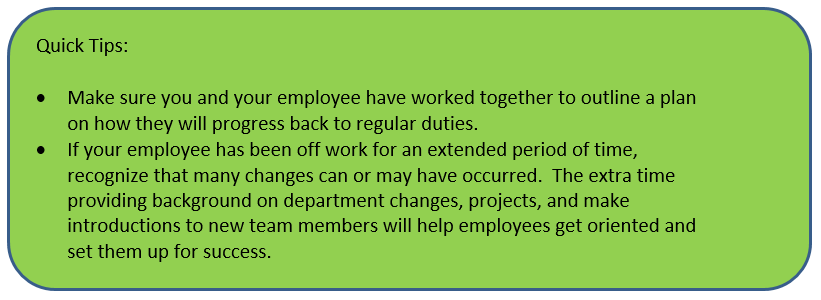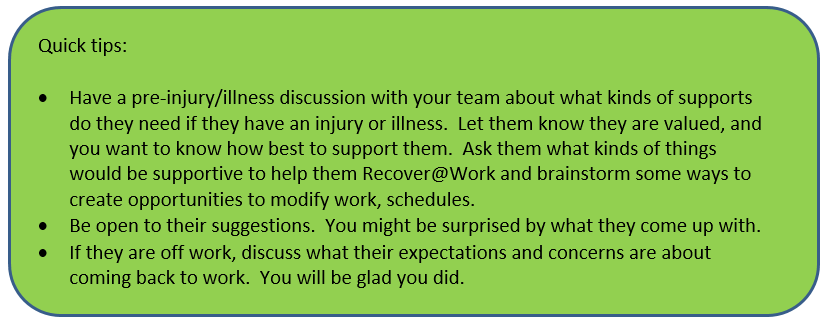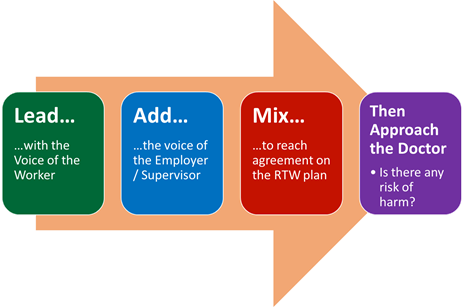There is a good chance one of your employees may experience a workplace or personal injury or illness at some point in their career with you. Not only does this create a disruption in the personal lives of your employees but also disruption to the department and the work you do for your customers and community you may serve.
The employee’s time off can create challenges for the department, co-workers, and there is often a sense of relief when an employee comes back to work. Relief that your colleague has returned from a difficult time and because the extra work absorbed by coworkers can now be handed back. Returning to work can involve many steps and it can be easy to underestimate what must happen before employees can return to full capacity.
Here are some tips and specific steps to take to set up your employees’ successful return to work.
How you respond matters
As the immediate supervisor, you may be a key individual to prevent the development of unnecessary work disability among employees. When your employees let you know they have had an injury or developed an illness, how you respond matters. Your response can impact on their commitment to the organization, can contribute to prolonged disability, and has been cited as a major determinant in their decision to return to work. In our recent workshops with supervisors the top reasons supervisors say can trigger a negative response on their part are:
- Previous bad experience with an employee or other employees who are off on a leave of absence, past unsuccessful outcomes
- For Workers’ comp claims, delayed reporting can invite us to feel unwarranted skepticism
- Our own biases
Employees may be hesitant to report an injury or illness for fear of the response from the supervisor. Or, in the case of a Workers’ comp claim may think the injury “wasn’t that bad” until several weeks later and they are not improving. In some cases, they are avoiding the hassle of ‘filing a claim’.

Make it a habit to Check-In During the Leave
Many employees report feeling disconnected from the workplace and don’t feel valued when they don’t hear from anyone for long periods of time or sometimes not at all. You probably meet with your teams on a regular basis as part of your regular work to discuss issues, current events, and changes that may be occurring. Similarly, plan to check in periodically with your employee on leave. Use your regular team meetings as a cue to call your employees who might be out of work. Just make sure there are not long gaps in your contact as the employee may question motives for calling. A good starting point is showing you care and that it is important for you to make sure they are doing ok. Employees who are kept in regular contact report feeling valued and engaged when they are out of the office, and it demonstrates your confidence in and support of their work.
It is good to talk directly to your employee but sometimes it is appropriate to use a quick text or email. Just remember, your best opportunity to offer support is when you can listen which can be hard through a text or email. And, there is good biological evidence to suggest that face-to-face interactions can trigger those relationship hormones that create strong bonds with those we interact with.

Become familiar with what Work Disability is
Work Disability is straight forward. If a person is unable to resume working, return to work, or their ability to perform their duties is altered in some way they are work disabled. Work Disability and Medical Disability are not interchangeable constructs. Work Disability is a separate condition with its own set of causes and own set of interventions. Supervisors/managers from our workshops state they observe the following top reasons for contributing to employees to be out of work longer than expected:
- System delays – delays in services, lack of resources, the system is poorly integrated and results in silos
- Don’t want to come back or lack of job satisfaction
- Fear of re-injury, not feeling ready, and anxiety about RTW
- Lack of communication, lack of ongoing follow-up
- Not engaged, don’t feel wanted back
Evidence confirms what supervisors/managers report experiencing. The top predictors for Work Disability outcomes have very little do with the actual medical disability the employee is experiencing. Medical Disability is insufficient to explain return-to-work outcomes and clinical severity is not predictive of Work Disability. Negative expectations about their return to work outcome and fear/avoidance beliefs, behaviours, and thoughts are the most robust and validated predictors of unnecessary Work Disability. Targeting employee’s beliefs, perceptions, and expectations and improving workers’ confidence about returning to work and reducing fear-avoidance beliefs are more likely to have a positive impact on the duration of expected RTW.

Actively involve your employee in their Recover@work plan
At the heart of a Worker-centric approach is whether your employee is actively participating in their Recover@work plan. Employees not being motivated to RTW is often cited as a challenge by supervisors/managers. Biology tells us that motivation is highly dependent on feelings of control. Having a sense of control is a biological imperative for triggering those parts of our neurology responsible for motivation and those parts of our neurology are activated when we are given the ability to make decisions and have choices, even if they are small.

Reach Out Right Before Their Return
Now that you have been successfully engaging and keeping your employees connected to the workplace by your regular contact, having a quick check-in before they begin their transition back to the workplace can be invaluable. The vast majority of employees have “Return-to-work jitters” prior to coming back. In fact, in our injured employee surveys, about 8 out of 10 employees state they have more than one concern about returning to work. They can be fearful of reinjury, unsure of how others will perceive them, worried about meeting performance demands and wondering if you will be supportive of their return. How many times have you experienced an employee who is supposed to return on Monday provide a doctor’s note on Friday at 4 pm saying the employee needs two more weeks? The pre-RTW check-in is a perfect time to offer reassurance, support, answer questions, and potentially prevent a last-minute decision to not return because of unaddressed concerns.

Transitional duties mean just that…transitioning
This is the essence of Recover@work. Early return to the workplace to recover on the job, when medically appropriate, is a proven success factor in the recovery and resumption of regular duties for employees. Remember the success of a Recover@work plan hinges on the employee’s input and involvement. The purpose of the transitional duties in a Recover@work plan is to transition the employee from being off work and progress them through the coming weeks to regular duties. An employee returning to work performing transitional duties without a plan to return to regular duties is unnecessary work disability waiting for the opportunity to take hold of your employee.

Return to work has been described as complex human behavior change with the employee remaining the ultimate agent of change in the return-to-work process and making the final decision regarding return to work. It has been cited by many authors that the “accuracy of a prognosis based on medical documentation in sickness absence forms, is lower than that of one based on direct communication with the sick-listed themselves.” This is the unspoken truth of the return to process.
 You might as well start your conversations with the employee first, mix in your department and operational needs and concerns, come to agreement about how the Recover@work plan will work, and then approach the Health Care Provider with the simple question,
You might as well start your conversations with the employee first, mix in your department and operational needs and concerns, come to agreement about how the Recover@work plan will work, and then approach the Health Care Provider with the simple question,
“Is there a specific medical reason why it would be unsafe or harmful to your patient to engage in this plan to return to work that we worked together to develop? If so, please explain the nature of the risk or harm as we might be able to accommodate.”
With a bit of deliberate work, empathy, and a process in place, you can ease the transition back for an employee on medical leave. Focusing on Work Disability Prevention principles and a worker-centric approach make a disproportionate difference in the motivation and empowerment of your employees.
If you want to know more about an evidence-based Work Disability Prevention program utilizing a worker-centric approach, please feel free to contact us.

